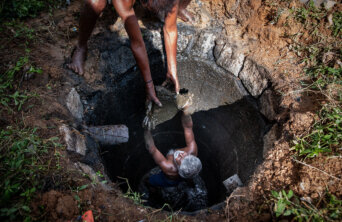- About
- Topics
- Picks
- Audio
- Story
- In-Depth
- Opinion
- News
- Donate
-
Signup for our newsletterOur Editors' Best Picks.Send
Read, Debate: Engage.
| topic: | Health and Sanitation |
|---|---|
| located: | India |
| editor: | Hanan Zaffar |
Indian government data states that there are about 60,000 manual scavengers, or people manually cleaning, carrying or disposing of human excreta, in India, while experts suggest that the number is much higher than stated. Census information suggests that over one-third of districts in the country are yet to declare themselves free from manual scavenging.
As per an NGO working for manual scavengers in India, between 2016 and 2020, at least 472 deaths occurred due to manual scavenging. The task of cleaning human waste is performed by those people who are considered to be in the ‘lowest of lowest classes’ in society, targeting low-income people.
While the government has been called out for not taking much action in this area, there have been several private initiatives by Artificial Intelligence (AI) and robotics enthusiasts to develop operations that mimic human movements with the aid of technology. These initiatives use sensors and cameras to enter manholes, navigate environments and stabilise surfaces.
For instance Generobotics, a start-up based in Kerala, has made a robot called 'Bandicoot' which is a mechanical scavenger that can be used to clean oily water sewers, stormwater sewers and storm drains in refineries. This robotic arm can execute a wide range of cleaning tasks, including shovelling, grabbing, picking and positioning a water jet. To ensure the safety and efficiency of sanitation personnel, it is fitted with a sensor to detect dangerous gases and specifically developed night vision cameras that provide images of the confined space via the user interface positioned above the manhole.
The use of these robots in sewage cleaning has the potential to increase productivity, decrease the likelihood of accidents and health risks and do away with the need for manual scavenging altogether. These initiatives can also largely lower the chances of many fatal diseases to workers.
Similarly, researchers at the Indian Institute of Technology in Madras, in the south Indian state of Tamil Nadu, have developed a robot dubbed HomoSEP to aid with the initiative's goal of putting an end to the terrible practice of manual scavenging once and for all. The 'HomoSEP' robot will be able to carry out all the tasks of a human scavenger.
In India there are now several different inspection robots in development that will make it easier to inspect and evaluate subsurface infrastructure apart from handling sewage. Cracks, leaks, blockages and structural deterioration in the pipelines can also be detected by analysis of the data generated by such robotic systems.
By using robots like these, domestic waste that has decomposed in septic tanks can then be cleaned up without any human touch, reducing contact with poisonous gases like methane (CH4), hydrogen sulphide (H2S), carbon dioxide (CO2), ammonia (NH3), nitrogen dioxide (NO2), and small amounts of carbon monoxide (CO), while also making sure that no person has to perform the degrading task of cleaning human waste.
Image by Sharada Prasad CS

